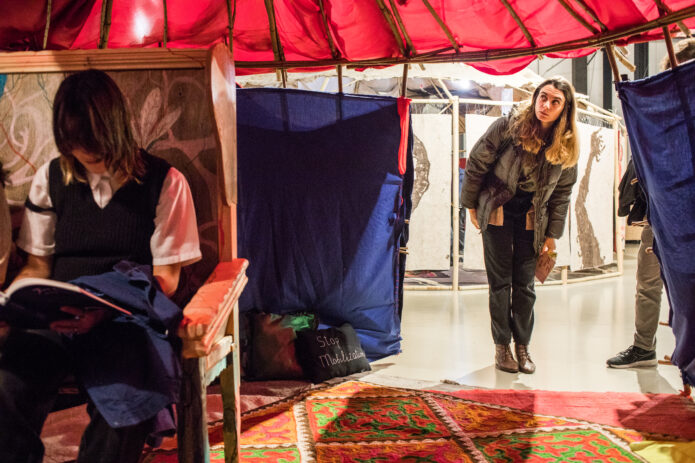 Installation photo from the exhibition 'To those who have no time to play' by Gluklya, curated by Charles Esche at Framer Framed, Amsterdam 2022. Foto: © Eva Broekema / Framer Framed
Installation photo from the exhibition 'To those who have no time to play' by Gluklya, curated by Charles Esche at Framer Framed, Amsterdam 2022. Foto: © Eva Broekema / Framer Framed Opmerkingen over de toegankelijkheid 1: heroverwegen en opnieuw leren
Recently, Framer Framed has been rethinking and relearning how we can improve access to our art space in every sense of the word. With any project, you have to start with the basics, so we began by researching the foundations of access theory to inform our stance and prepare us for the physical changes to our space. In the first part of Notes on access – our magazine series following our journey towards access – we consider the routes of crip theory, and how it should be informing our practice, followed by some thoughts on access intimacy.
Eve Oliver, November 2022
The systems and structures which exist in this era of neoliberal capitalism facilitate the exclusion of minorities who do not fit neatly into the box of whiteness, able-bodiedness and masculinity. Within this reality, the intersection between heterosexuality and able-bodiedness solidifies as people who deviate from these categories mutually critique the celebration of normalcy. This repeated intersection has determined the important collaboration of two previously disparate studies, queer theory and disability theory, which has been coined crip theory by Rob McRuer.[1] To contextualise crip theory, we begin with the foundations of queer theory, which, at its core, believes that heterosexuality, in the past, has masqueraded as the natural order of things, ascribing to it a non-identity whereby anything deviating from it was hyper-visible, jarring and abnormal. In the same way, McRuer cites that crip theory questions the natural order of things, and able-bodiedness, even more than heterosexuality, is still considered compulsory and has been naturalised. He believes that “compulsory able-bodiedness” which produces (dis)ability, is interwoven with the system of compulsory heterosexuality, which produces queerness. This intersection of naturalisation has reinforced dominant ideologies of gender, race, sexuality and ablebodied-ness, and all are contingent on one another. To challenge this is to be an activist, and we see art as an effective means of disparaging the dominant paradigms which determine which people are treated justly in the world.
With crip theory expanding and dominating many areas of cultural analysis and art, Framer Framed’s interest in this area has grown simultaneously. Aligning with its core values, we believe that diversity produces authenticity in creative settings. This is why we are aiming to improve access and, in turn, inclusivity to all our events and workforce. On that note, activism must start with representation – representation of diverse identities within our workforce, our collaborators, our public programme, and our projects. Only with a multi-perspectival approach can our rhetoric begin to imitate and include the variety of identities which characterise the world at large, and we can begin to build accessibility into our institutional DNA. We can do this by collaborating with valuable stakeholders, such as members from disability activism groups; trialling multi-sensorial approaches to interpretation; practising representative hiring schemes; taking training on access; and, being open to relearning the mistakes of the past.
With this belief in collectivity comes the impetus for our art space to be hospitable physically and emotionally for all people who visit and collaborate with us. It falls on the shoulders of all members of our community to contribute to access intimacy. We learned about the term “access intimacy” from activist and writer Mia Mingus, who defines it as the missing link to what creates authentic, compassionate access support.[2] She says it is an explicable feeling of solidarity and emotional support, where a (dis)abled person’s body feels cared for and their access needs are understood. It can take time for such intimacy to be achieved and it is usually a rare connection between two people. Although the concept of access intimacy was written in relation to interpersonal relationships, its premise is something we can apply to our daily working styles. Thinking beyond our lived experience is imperative to empathy, and we see this as a defining characteristic of access intimacy. If we incorporate peripheral thinking into our workplace behaviours and policies, remnants of access intimacy will manifest for visitors and members of our spaces. In this way, the concept is not exclusive to human relationships, but it can also be used to create a feeling of intimacy and care within a physical space. Therefore, we aim to create a space which is open to supporting and listening to diverse needs, and in doing so challenges neoliberal capitalism which sees interdependence as something to avoid. We hope that art spaces, including our own, can respond to this area of thought and join crip theorists in our joint journey towards a more accessible world and future.
Keep a look out for our next instalment of Notes on access in the next few months, as we write about the steps we are taking to improve access, and in turn, diversity, in our community.
[1] McRuer, Robert. Crip Theory : Cultural Signs of Queerness and Disability. New York: New York University Press, 2006.
[2] https://leavingevidence.wordpress.com/2011/05/05/access-intimacy-the-missing-link/ [Accessed 29th August 2022].
Action Research / Community & Learning / New Museology /
